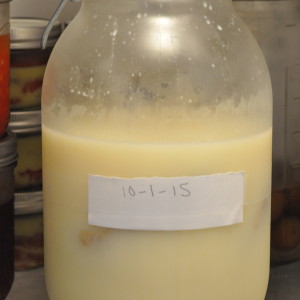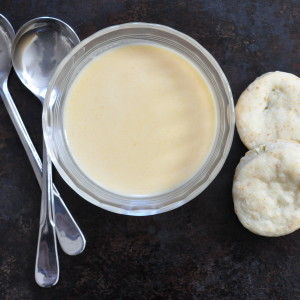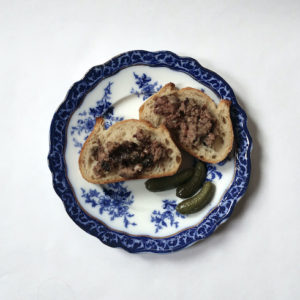Plain Roast Duck
“Every once in a while, even the most sensible person gets a craving for roast duck.”
Laurie Colwin, “The Duck Dilemma.”
As I crave duck almost continually, I either lack sense (entirely possible) or was French in a past life (a preferable interpretation).
People–and by people, I should specify Americans–tie themselves in knots over cooking duck. It is viewed in the States as a special occasion bird, considered both expensive and fatty. And unless you keep company with hunters, these allegations are often true.
This said, it is possible to locate reasonably priced, quality ducks. Careful preparation helps mitigate excessive fattiness. I mean, does anyone really think centuries of French peasants were spreading Earthbrew butter substitute on their baguettes or preserving goose with with something from a plastic tub?
So say you went shopping and an inexpensive duck placed itself in your path. By inexpensive, I mean a Mary’s Four-Pound Free Range Duckling, costing $19. Don’t shriek. You’ve paid that much for a chicken, right? Or a nice piece of steak?
Look, I haven’t come into an inheritance. But consider a little duck math. One four-pound duck will feed two, maybe three for dinner. You are then left with a wonderful carcass to make into the most delectable, lipsmacking of broths. Divide your $19 into two or three meals–math even I can cope with–plus all that broth, and suddenly your duck is much cheaper.
Many are the complex duck recipes floating about. Indeed, one has even floated about here, in the form of duck confit. But today, in the hopes of making duck a little less forbidding, we’re just roasting ourselves some plain duck.

The late Judy Rodgers, whose Zuni Café Cookbook radically improved my cooking, got me in the habit of pre-salting meats, poultry, and fish. This will not make your food dry or salty. Rather, careful pre-salting acts as a preservative while deeply flavoring foods. You’ll also find yourself using drastically less, if any, salt at table.
Meats and poultry may be salted up to three days before cooking. Fish, being more delicate, should be seasoned only a few hours before cooking.
How much salt? This is a matter of taste and of what you’re salting, but Rodgers figures about 3/4 teaspoon per pound of meat or chicken. Obviously, thinner pieces of meat require less salt.
What kind of salt? Again, taste is a factor, but decent Kosher salt is inexpensive. In My Paris Kitchen, David Lebovitz writes about finding all the business of different salts ridiculous until he tasted several, including common table salt, which tasted shockingly chemical.
My preferred salt is Maldon, which is expensive. Feel free to use Kosher. Again, use your eyes, hands, and most importantly, your taste buds.
I used just under a tablespoon of salt for this duck, and salted it one day ahead of cooking.

A couple tips: I wrap the wingtips in foil, as they seem to burn almost immediately. I also line the baking pan with foil. Said pan is an old Pyrex glass baker. While a Staub pot would be more authentically French farmhouse, it would also be authentically hellish to clean.
Duck releases lots of fat while roasting. That fat must be removed from the pan, lest overflow cause unpleasant oven events. Bulb basters are useful for this task, provided they work well. Some people have cheap bulb basters that drip right back into the pan, making them useless. For them, large spoons are useful. Spoon the fat into a clean jar and use it for cooking, unless you’re the type who considers duck fat poison. If you are, please mail your fat to me. Whatever you do, never put duck fat down your drain.
This is a fine time to discuss what bloggerese calls the “featured image.” You’ve noticed what it’s not: a glistening, beautifully roasted duck, gloriously arranged on a serving platter. Nope. No duck, glistening or glorious.

Okay, so, I have photographs of a duck. On a platter. And they’re lousy. Attempts at carving the duck breast for the “fanned across white plate shot” also failed.
By then I was losing the light, my right arm seized in a cramp, and the kitchen, already a war zone, further deteriorated when the garbage disposal quit.The faucet, feeling lonely, decided to join the party by coming away the from sink mount. So much for “set featured image.”
There was nothing for it but cleaning up. I started with the cutting board, and I kid you not, there were the shallot peels and garlic, the sun streaming in just so. So hey, you know what a roast duck looks like. I know what a roast duck looks like.
Here’s how to cook one.

Plain Roast Duck
Yield: 2 servings
Prep Time: Approximately 3 hours roasting time
1 4-5 pound duck, fresh or frozen
2-3 russet potatoes, peeled and thickly sliced
1-2 onions or shallots, peeled and thickly sliced
2-3 carrots, peeled, cut in longish pieces
As many large garlic cloves as you wish, left whole and unpeeled
a little salt for the vegetables
salt for the duck if you haven’t pre-salted (see discussion of pre-salting, above and in instructions below)
a good grinding of black pepper
a little Vermouth or white wine for the pan
optional, for the cavity:
piece of bread, more garlic, half a lemon
Pre-salting the duck (optional)
Up the three days ahead of cooking, remove giblets. Rinse bird in cool water and dry very well. Using about 3/4 teaspoon sea or Kosher salt per pound, salt bird inside and out. Place on baking sheet or pan that will hold duck comfortably. Cover loosely with foil. Refrigerate.
Take duck out of refrigerator one hour before cooking.
Preheat oven to 400 F/200C
Place duck in large roasting pan or leave it in pan it presalted in.
I like to line the pan with foil, for ease of cleaning later.
Either cut wingtips off with sturdy scissors or wrap them with foil to prevent burning.
Surround with duck vegetables of your choice: potatoes, carrots, onions and/or shallots, and the unpeeled garlic.
Place heel ends of bread, more garlic, or lemon in the cavity.
Pour a little Vermouth or white wine into the very bottom of the pan
If duck is pre-salted, salt the vegetables only. If duck is not pre-salted, salt everything generously. Add pepper.
Place in oven. Have jar or other heat-proof, food-safe vessel ready.
Cook duck at 400F/200C for one hour, checking every 15-20 minutes to remove the excess fat from the pan. Be extremely careful while doing so; frequent checking makes this safer and easier. As the duck cooks, it will let off less fat.
After one hour, turn the oven down to 325 F/160C. Cook for another 2-2 1/2 hours, until the duck is absolutely tender. The legs should wiggle free easily, even start coming away a little bit. If the skin starts browning too much in the final hour, cover with foil.
It’s okay to leave a little fat in the bottom of the pan. Turn the vegetables gently so the upper portions don’t dry out.
Best served with green salad.
Notes:
Giblets are highly perishable. Either freeze liver immediately or sauté in a little butter or olive oil and eat within two days.
Heart, gizzard, and neck may be lightly salted, then roasted with bird or frozen for broth making. Keep refrigerated at all times.
Pretty picture of ingredients used with the duck. But not the duck.

A final note: my review of Toni Tipton-Martin’s The Jemima Code is here. This extraordinary book has been nominated for a James Beard Award, as has Nancy Singleton Hachisu’s Preserving the Japanese Way and Diana Henry’s A Bird In The Hand. I am thrilled to see these immensely deserving titles receive the recognition they deserve–especially Tipton-Martin and Hachisu’s books. Henry is famous in her native UK. Tipton-Martin is an academic, meaning she’s not widely known here in the States. And Hachisu is so intelligent that I frankly despaired of her ever receiving wide recognition. Call me jaded or negative. Now, with the Beard nomination, you can also call me wrong.




